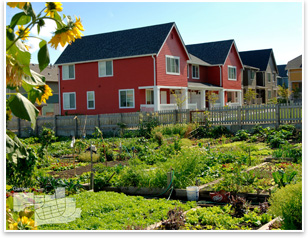
The New Suburban Migration by Zach Mortice
Summary: Although most housing policies still concentrate affordable housing in central cities, for the first time more poor people live in suburbs. To combat this contradiction, AIA members and knowledge community affordable housing experts propose linking affordability with sustainability and developing architects’ role as community advocates. Since the 1920s, when the number of Americans living in urban areas surpassed the number of Americans living in rural areas, perhaps the greatest modern demographic change has been the post-war explosion of suburbs. Today, 50 percent of Americans live in suburbs. Two years ago, another silent threshold was crossed that fundamentally changes how people think about the relationship between city and suburb: For the first time, more poor people live in suburbs than in cities. According to a study by the Brookings Institution, in 2005, the suburban poor outnumbered their city counterparts by 1 million, yet housing policies still concentrate affordable housing stock in central cities. This suburbanization of poverty is driven by changing immigration patterns and the decentralization of low-wage jobs and has helped to fuel a growing affordable housing crisis. About 86 percent of metropolitan renters live in places where a full-time job at minimum wage is not enough to pay for a two-bedroom apartment at the market rate, according to the National Low Income Housing Coalition. AIA members and knowledge community leaders are developing various strategies to satiate this dire public need, and, perhaps surprisingly, technical design considerations are only a small part of it. For Bill Roschen, AIA, of Los Angeles-based Roschen Van Cleave Architects, architects need to address the affordable housing crisis by linking together affordability, livability, and sustainability as mutually reinforcing goals. “As architects, we can be very involved not just with the design of the building, but [by] influencing land-use strategy in our own communities,” he says.
The conventional stereotype of suburbanites chanting “Not in my backyard!” when affordable housing is proposed is real and well understood, but Georgopulos says the motives behind the chant aren’t always examined. There’s often more to this reaction than greed jealously guarding property values. In Massachusetts, public schools are funded by real estate taxes, and Georgopulos says a community may resist low-income housing because they fear that schools will be burdened with more students while low-income parents pay less real estate tax into the district’s coffers than their neighbors. “You do need a policy framework where you can mediate these differences so that you’re coming up with an outcome that actively reflects the kind of real context [in the community],” she says.
“A lot of companies aren’t going to move into an area if they can’t provide a variety of housing in a location close to them,” she says. “There are a lot of employers getting onboard with this because they do see this not as a housing issue per se, but as an employment issue.” Ahrentzen works for Arizona State University’s Stardust Center for Affordable Homes and the Family, a research, design, and education center for affordable housing that operates primarily in the Phoenix area. Now the nation’s fifth largest city, Phoenix has proved to be a formidable proving ground for expanding the stock of affordable housing in a sprawling Sun Belt city. From 1990 to 2000, the Phoenix metropolitan area grew 45 percent, adding over a million people. The “D” word In his firm and in his knowledge community, Roschen encourages architects to become more involved with their local community. He says this is the best way to be a convincing advocate for affordable housing and to help overcome the stigma these projects can carry. The task, it seems, is to win over residents’ trust. “There’s a lot of cynicism and mistrust out there between communities and their politicians, between communities and their planners,” he says. “I think architects are a tremendous bridge of credibility between them.
|
||
Copyright 2007 The American Institute of Architects. All rights reserved. Home Page |
||
For more on density and livability, visit the AIA’s Communities by Design Web site.
Photos
High Point, outside Seattle, by Mithun, a 2007 AIA Housing Awards winner replaces 716 subsidized housing units erected after World War II with 1,600 units designed in a fresh take on traditional residential forms. Half of the new homes are designated for low-income residents. Photo ©: Doug Scott
Bridgeton Hope VI, Bridgeton, N.J., by Torti Gallas and Partners, another 2007 AIA Housing Awards winner, uses infill new housing, filling vacant lots and blocks as riverside parkland. Porches, cornices, surrounds, siding, and trim, all painted with a varied historic pallette, allow the houses to blend with the neighborhood. Photo ©: Hedrich Blessing.
Salishan Neighborhood Revitalization c/o Tacoma Housing Authority,Tacoma, Wash., by Torti Gallas & Partners, Inc., is a HOPE VI Grant project, which, as well as revitalizing the neighborhood, achieves 91 percent filtration of all storm water on-site, vastly reducing the amount of pollution flowing into nearby Swan Creek. Photo ©: Steve Hall.



